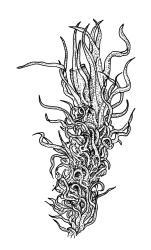- = Bryodixonia Sainsbury, Trans. & Proc. Roy. Soc. New Zealand 75: 177 (1945)
- = Plenogemma Plášek, Sawicki & Ochyra, Acta Mus. Siles. Sci. Nat. 64: 172 (2015)
- = Rehubryum F.Lara, Garilleti & Draper, Front. Plant Sci. 13: 10 (2022)
Plants mostly small, forming tufts on bark or on rock, dull, mostly green to yellow-green above and dark brown to ± black below. Stems erect or ascendant, simple or sparsely forked, densely leaved, beset below with smooth, brown rhizoids, in cross-section with small, incrassate cortical cells, thick-walled internal cells, and lacking a central strand. Leaves erect-spreading when moist, mostly strongly contorted when dry, lanceolate from a ± ovate and concave base, acute or acuminate, keeled above, entire, margins recurved (especially when dry) or ± plane; upper laminal cells subquadrate to irregularly rounded, often some oblate, thick-walled, unistratose or rarely bistratose, papillose, mammillose or smooth; basal interior cells elongate to linear, thick-walled and often porose, coloured, usually smooth, often appearing to radiate from the base of the costa; cells of basal margins differentiated, ± quadrate, pale, with thickened transverse walls, forming a basal border 1 to several cells wide. Costa strong, mostly ending just below apex, in cross-section lacking stereids. Gemmae rarely present.
Autoicous or rarely dioicous (mainland N.Z. taxa probably all gonioautoicous). Perichaetial leaves mostly not or only weakly differentiated, rarely strongly differentiated. Perigonia gemmiform, scattered below the perichaetium. Setae single, straight, elongate or rarely short; capsules ± exserted or rarely immersed, mostly cylindric, occasionally obovoid-cylindric or rounded-urceolate, with a long, tapered neck, distinctly 8-ribbed when dry or occasionally merely puckered at mouth; exothecial cells ± rectangular, in alternating bands (the thicker-walled cells corresponding with ribs in dry capsules), the longitudinal walls variably incrassate and the transverse walls usually relatively thin; stomata superficial, restricted to the neck and lower portion of urn, usually numerous; annulus weakly differentiated; operculum rostrate from a convex or conic base. Peristome usually double; exostome teeth 16, usually paired, broadly triangular and obtuse, with a median zig-zag line clearly visible on both surfaces, mostly reflexed when dry; endostome arising from a low membrane, the segments 8, rarely 16, or lacking; preperistome lacking. Calyptra mitrate-campanulate, lobed at base, mostly densely hairy. Spores unicellular or rarely multicellular.
The Australasian species of Ulota were treated by Malta (1933). Malta’s treatment was adopted, with minor changes, by Sainsbury (1955). In my opinion, both Malta's and Sainsbury’s species concepts are excessively narrow and fewer species are recognised in this treatment.
Ulota is a moderately large genus occurring in temperate to cool regions of both hemispheres; it is absent from tropical regions. Smith (2004) indicated that the genus includes "about 35 species". These occur predominantly on bark, but some species occur on rock. Four indigenous species are recognised in N.Z., with a fifth, U. phyllantha, known only from Macquarie I. and apparently adventive there. This represents a substantial reduction compared to the nine species (plus one atypical variety and one species of Bryodixonia) recognised by Sainsbury (1955).
| 1 | Apical (immature) leaves bearing conspicuous red-brown gemmae in clusters at their tips; dioicous and sterile (in Australasia); occurring mostly on rock (rarely on wood or peat), maritime and known regionally only from Macquarie I. | U. phyllantha |
| 1' | Apical leaves lacking conspicuous gemmae; gonioautoicous and usually fruiting; mostly epiphytic, rarely on rock, not restricted to maritime areas and widespread in N.Z. | 2 |
| 2 | Perichaetial leaves much longer than vegetative leaves; calyptra small, enclosing only the operculum and mouth of the developing capsule; capsules immersed; endostome absent | U. perichaetialis |
| 2' | Perichaetial leaves not or weakly differentiated from vegetative leaves; calyptra enclosing the operculum and most or all of the developing capsule; capsules exserted; endostome present | 3 |
| 3 | Spores multicellular and large (>65 µm, mostly 75–90 µm); cells of basal margins forming a border c. 3–4 cells wide; capsules narrowly obovoid when moist; endostome with 16 broad (but often fragile) segments | U. membranata |
| 3' | Spores unicellular and smaller; cells of basal margins forming a wider border; capsules more or less cylindric when moist; endostome with 8 (rarely 16) narrow segments | 4 |
| 4 | Vegetative leaves not or moderately crisped when dry; stems creeping and much branched; endostome segments 1 cell wide near base; stomata numerous in upper neck and lower portion of urn | U. viridis |
| 4' | Vegetative leaves strongly crisped when dry; stems erect and sparsely branched; endostome segments usually (at least some in each capsule) >1 cell wide, and with a median line for at least part of their length; stomata restricted to neck, not extending to capsule urn | U. lutea |
| Category | Number |
|---|---|
| Indigenous (Endemic) | 1 |
| Indigenous (Non-endemic) | 3 |
| Total | 4 |




